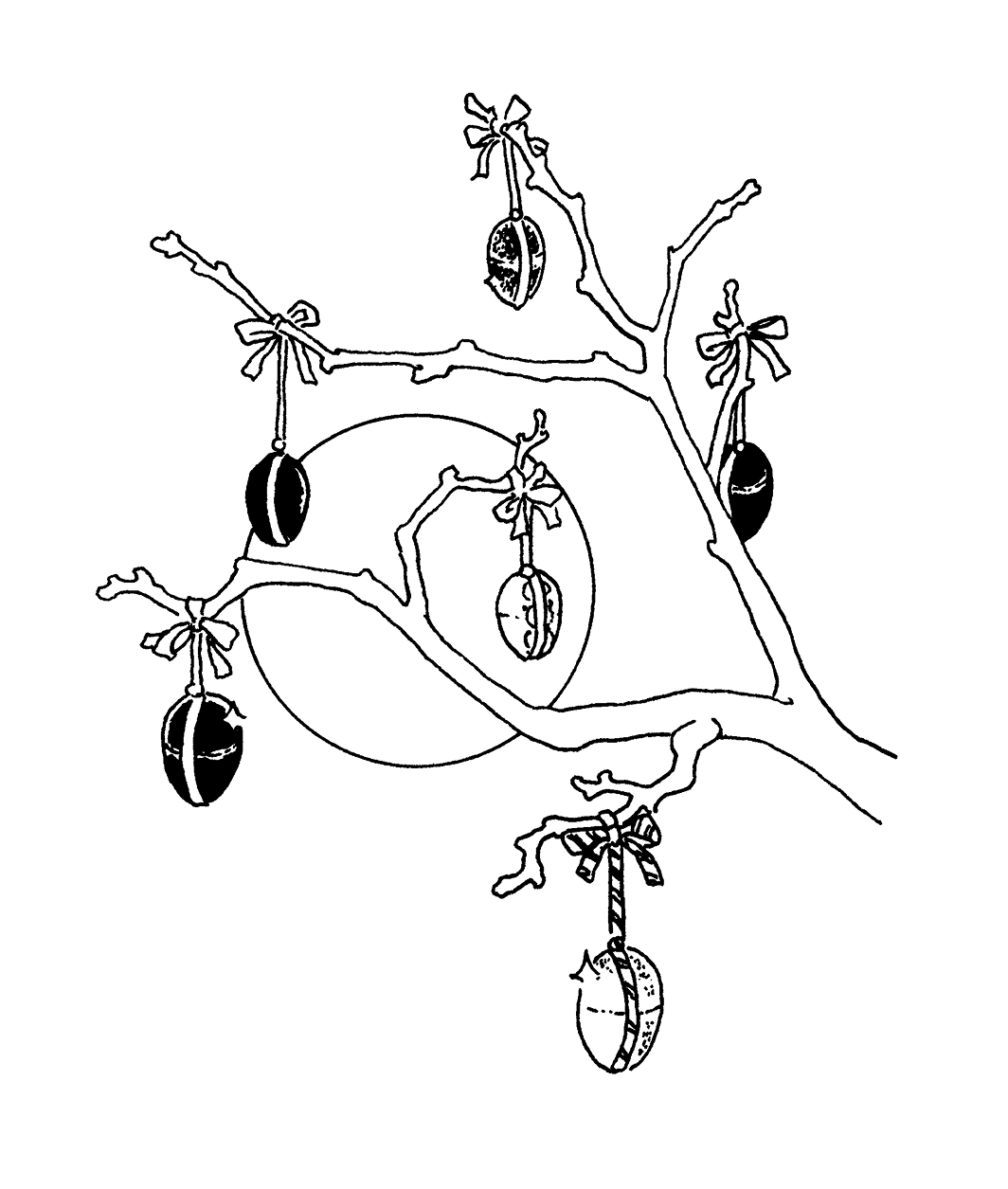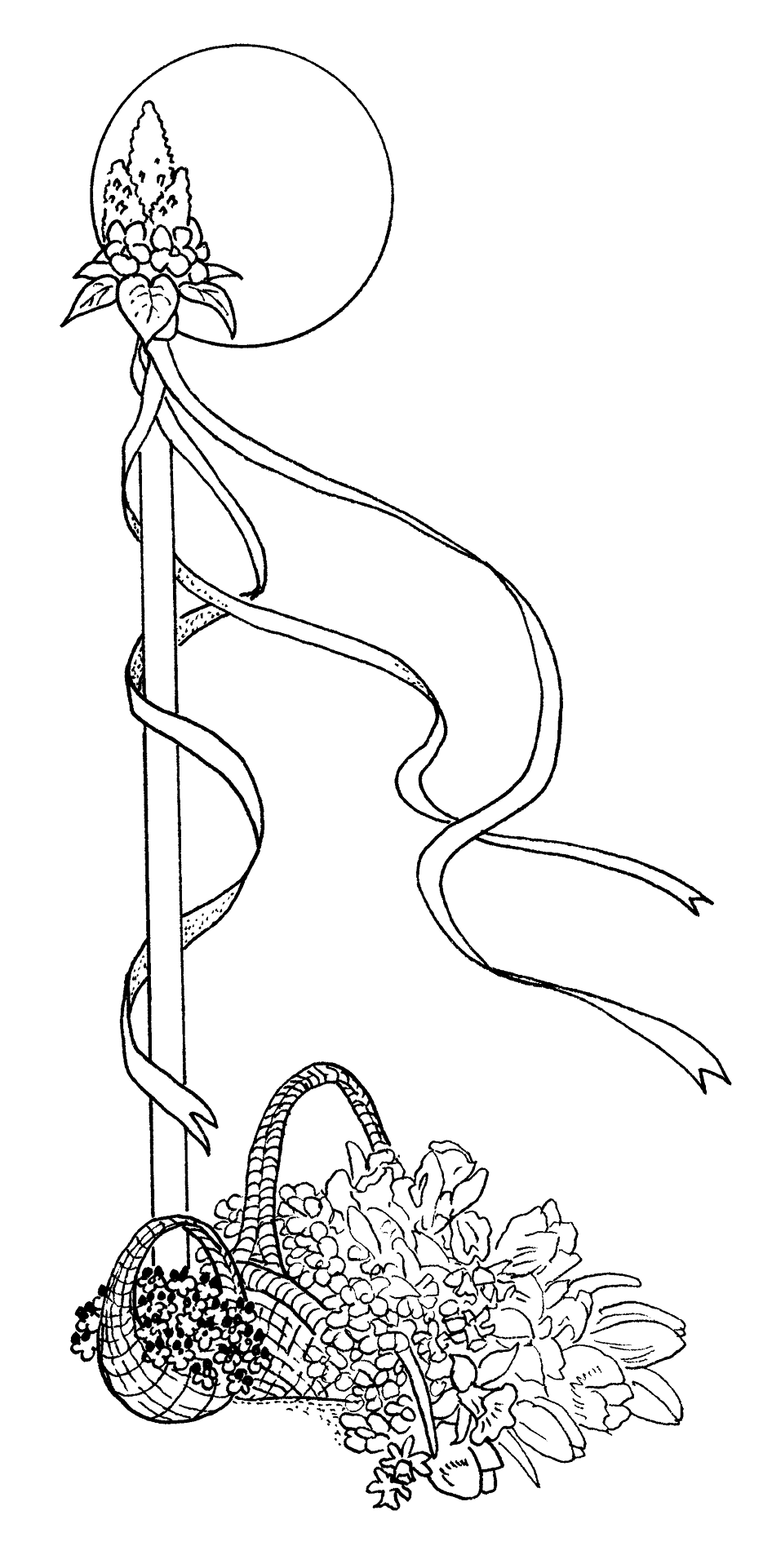Garden Witchery (19 page)
Authors: Ellen Dugan
Tags: #herb, #herbal, #herbalism, #garden, #gardening, #magical herbs, #herb gardening, #plants, #nature, #natural, #natural magick, #natural magick, #witchcraft, #wicca, #witch, #spell, #ritual, #sabbat, #esbat, #solitary wicca, #worship, #magic, #rituals, #initiation, #spells, #spellcraft, #spellwork, #magick, #spring0410, #earthday40


Dyeing eggs with your family is one of the many pleasures of the spring equinox. The night before the equinox, I pick up some egg dye from the grocery store (they put out holiday stuff so early these days). Yes, I know, it blows my image not to be using natural egg dye, but sometimes you have to be practical.
There are many recipes for natural egg dyes, some complicated and others not. One of the best and easiest that I've found is to boil the eggs with purple cabbage leaves. After boiling for ten to fifteen minutes, move off the heat and let the eggs sit in the pan, covered by the liquid and the leaves, overnight. In the morning the eggs will be a bright robin's egg blue. But the color is fragile and scratches off easily, so handle them carefully.
So choose your dyes, natural or storebought. Cover the counters with paper and turn the kids loose. At our house we boil up a couple dozen eggs. The kids dig out a white crayon and mark the eggs with suns, butterflies, our names, stars, and crescent moons. They elbow each other out of the way and fight over the purple egg dye. My three teens tease each other unmercifully and have a great time razzing each other about their egg-coloring skills.
On the morning of Ostara, I make cinnamon rolls to celebrate, and when the kids were small, the bunny hid their eggs. The traditional egg hunt was completed first thing in the morning.
Now I serve up breakfast and hand out the presents. It amazes me just how fast a “cool” teenager reverts to childhood when faced with chocolate. “Mine!” is usually the battle cry.
Now that my kids are older I may give the boys gift certificates to a video store or jumbo packages of gum, and they all get a big candy bar. My daughter usually requests a Beanie Baby or a pair of earrings for her basket. (She still insists upon using her old purple basket.) The boys are happy with their gifts in a gift bag. It's a guy thing.
A few days before Ostara, my spring wreath goes up, along with a block set I made that spells out “Happy Ostara.” This is displayed on a shelf in the living room. Check out your hometown craft store and purchase precut two-inch wooden blocks. Paint them white and then, using an alphabet stencil, choose a pastel-colored paint and stencil on the letters to spell out your message. Tip: Make your block set reversible and stencil a different greeting on the reverse side, like “Happy Beltane.”
A nice spring display for your mantle or table would be decorated eggs, topiaries, ceramic white rabbits, bird's nests, and fresh flowers. Clip some daffodils and tulips from your yard, put them in an old canning jar or vase, and work in some twigs of blooming forsythia or pussy willow for a casual homemade arrangement. Try lining an old stoneware or wooden bowl with moss and fill it up with artificial eggs. Save the eggs and reuse them every year.
Check out the florist or garden center for pansies and violas, you can plant these now. I love pansies in containers and window boxes. Pansies will tolerate most cold weather, though if the cold swings back into extreme temperatures, you may have to cover them up for a night or two.
Also at this time of year, hyacinths, tulips, and daffodils in gift containers become available. Blooming bulbs in baskets or wrapped pots would make a nice centerpiece for your table. And you can jazz it up a little. Cover the soil with sheet moss and then tuck some pastel eggs into the moss for a delightful display. Happy spring!
O'Brignal banks are wild and fair
And Greeta woods are green,
And you may gather garlands there
Would grace a summer queen.
Sir Walter Scott

May Day/Beltane
As I write this, it is Beltane day, May 1. The mantle is decorated with moss-covered topiaries, a bird's nest, and birdhouses. The wood-burning stove has been cleaned out for the summer, and my big old cauldron is on the hearth, filled with a trailing ivy.
By Beltane the garden is really greening up, and the early blooming plantsâsuch as lily of the valley, bleeding hearts, and columbineâare blooming prettily. The hostas are filling in and the astilbe are beginning to show color. The ferns are thickening up and growing taller. The two new hanging baskets that I planted last week are starting to fill in more, the snaps are taller, and the allysum is fuller. The pink and dark purple petunias are blooming well now, and smell terrific after sundown. My climbing roses, of the variety
Zephrine Drouhin
, are setting blooms, and in about two weeks they will put on a traffic-stopping performance in cerise pink.
The pansies that I planted in March are really luxurious now. The peonies are showing color, and I find myself checking the garden to see how many plants need to be transplanted or thinned out. My husband is in his search-for-the-most-interesting-heirloom-tomato mode, and I can't seem to make it past a flower stand or nursery without stopping, for just a quick peek.
Ah, May. The time of year when the bugs aren't too bad and you can enjoy a evening outdoors without the bug spray. Here in Missouri, it is now safe to plant those tender annuals like impatiens, begonias, and petunias. I find myself looking forward to the full moon in May; we call it the faery moon at my house. This is the night when I bless the garden and all of the herbs, flowers, plants, trees, and vegetables we care for in our yard. Both Beltane and the faery moon are magickal times for gardens and gardening.
Beltane is a fertility festival. Opposite on the wheel of the year from Samhain, it is an in-between time. The boundaries between our world and the other realms are thinnest at Samhain and Beltane. For those who wish to commune with the faery realms, Beltane would be the time to try. Refer to chapter 7 for more faery information, and be careful! You just might get what you ask for.

The maypole is a customary symbol of this day, as well as bright, ice-cream colors for its ribbons or, if you prefer, the more traditional red and white. May baskets hung on doors, stuffed full of flowers, are customary decorations, as well as flower garlands woven for the hair. Check those floral languages and leave someone an enchanted message bouquet.
At my house, if the weather cooperates, we have a barbeque and eat our dinner outside. I usually serve strawberry shortcake for dessert.
Later, after the kids go to bed and I have some alone time, I head outside to the garden for a chance to be alone with the Lord and Lady to thank them for their blessings and maybe, just maybe, to catch a glimpse of the faeries.
A noise like of a hidden brook
In the leafy month of June,
That to the sleeping woods all night
Singeth a quiet tune.
Samuel Taylor Coleridge

Midsummer/Summer Solstice
Midsummer or the summer solstice is on or around June 21, the longest day of the year and the shortest night. Decorating ideas are seashells and starfish arranged across your altar or mantle. You could really be subtle and go Americanaâuse architectural stars and folk art in country colors of blues and reds.
Midsummer is celebrated at my house by barbequing, going to the pool, camping, or the occasional fishing trip. Some other ideas for celebrating the solstice are midsummer garden parties, going on a picnic, or taking a trip to the lake or beach.
To create an inexpensive midsummer garden party, keep the menu fresh and light. Decorate a picnic table if you have one, or drag your kitchen table out to the garden. Use a tablecloth in any pretty pastel shade and either use floral theme paper plates or your good dishes. I like to mix and match glassware and plates for a more informal look. You might try picking up some plastic tumblers in bright shades of hot summer colors.
How about creating individual tussie-mussies for your guests or, better yet, have everyone make their own while they are at the party? Put a pretty book on the table explaining the symbolism of the flowers, set out some supplies and flowers, and turn them loose.
If you are having your magickal friends over, try a solstice/celestial theme: gold suns with blue and gold plates and napkins. Sprinkle some glittery stars and moon confetti on the tablecloth. If children are invited, you could make it a faery party. Let the little ones dress up as faeriesâthe adults, too, if they wish. Embellish place cards with glitter pens and floral, faery, or celestial stickers, depending on your theme.
Snip some blooming roses off your bushes and use garden flowers and blooming fragrant herbs for a centerpiece. For faery lights you can use old glass canning jars with a tealight inside and set them in a row down the center of the table or place them throughout the garden. After the sun goes down, light up some sparklers for the kids and the adults. Have an enchanted midsummer's night!
Summer afternoonâsummer afternoon;
to me those have always been the two most beautiful words in the English language.
Henry James

Lughnasadh/Lammas
Lughnasadh is the first of three harvest festivals, and baking bread is traditional. However, I use a bread machine. I love those things! If time is an issue, you could make cornbread. Pick up a mix at the store and whip it together. My kids like to make cornbread, it doesn't take any longer than a few minutes to mix it up and pop it into the oven. Serve it with butter, honey, or maple syrup.
Decorate your home and altar with sunflowers, gourds, wheat, and scarecrows. Make a basket centerpiece with gourds and ornamental corn. Use a flat-bottom basket and arrange the gourds and corn around a central yellow or orange pillar candle.
